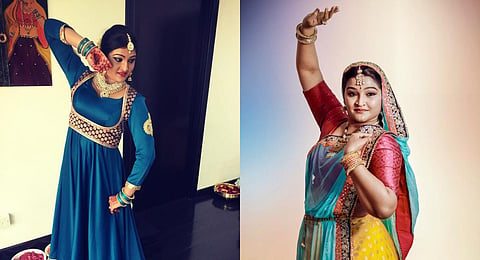

KOCHI: Kathak, traditionally known as the Luv-Kush dance, is one of the more prominent dance forms in the vivid cultural mosaic of north India. From its origins on the streets as a folk tradition to a symbol of bhakti in hallowed temples and a refined art form in opulent royal courts, the classical dance gracefully evolved over time.
Captivating audiences with its melodic allure and emotive storytelling, Kathak boasts a history embellished with influences from Hindu as well as Islamic traditions – a rarity in the case of classical dances.
Kathak’s diverse forms include subtle regional variations, each reflecting the cultural richness of its origins. The Lucknow, Jaipur, and Benares gharanas are some examples of how Kathak branched out and flourished across northern India.
Vaani Grace, a Kathak exponent and mentor, has been at the forefront of popularising this beautiful art form in Kerala. Recently, she opened the doors to the Grace Academy in Kalamassery, Kochi, with a vision to preserve and impart the authentic essence of Kathak to aspiring students.
In a region where Kathak is relatively less popular, Vaani’s initiative has garnered considerable interest from the younger generation. “Authenticity lies at the heart of our endeavour. To truly comprehend Kathak, one must embark on an exploration of its very roots,” Vaani asserts.
“However, artists tailor their creations to resonate deeply with their audience, just as Kathakars did throughout history, adapting performances to enchant their spectators.” Vaani began her journey at the renowned Bhatkhande Sanskriti Vishwavidyalaya in Lucknow, where music, dance, and theatre blend seamlessly. Under the tutelage of esteemed gurus, Vaani immersed herself in the old-school charm of the art form.
Specialising in the Lucknow gharana, celebrated for its graceful expressions and intricate footwork, she honed her skills with utmost devotion. “Dance transcends mere physical expression; it is a language of emotions, where artists breathe life into their movements, leaving indelible impressions on the heart,” says Vaani.
Beyond the virtuosity of motion, Kathak is an art form that resonates with myriad perspectives, she adds. “As artists, we commence with an ephemeral idea, gradually weaving intricate stories that resonate with audiences,” says Vaani.
“Dance is not merely a physical expression, but a language where the artist becomes the pen and the soul becomes the ink. As artists, we have the ability to create something entirely new and offer a deeper perspective. While others may see, we observe. An artist who knows the ‘language’ distills ideas that are scattered as thoughts in their imagination. From those ideas, stories emerge.”
Music plays an integral role, too. Artists, through rhythmic support, compose their music. “Musical compositions form the skeleton of the art and story that the artist builds,” explains Vaani. “Kathak, a classical dance form, extensively incorporates various ‘taals’ from Hindustani classical music. The dance’s foundation is built upon taals of 16, 10, and 14 beats.
A significant characteristic of Kathak is its pirouettes, known as ‘chakkar’. During the dance, the dancer responds to the rhythms played by musical instruments through intricate foot movements. The dancer often recites these rhythms, creating a harmonious interplay of sound and movement.”
Another essential element of Kathak is the use of ‘ghungroo’’, the ankle bells worn by the dancer, which produce complex rhythmic patterns as they shake, adds Vaani. “In its purest form, Kathak mesmerises the audience with its elegance and complexity, as the dancer gracefully executes the intricate footwork and rhythmic patterns,” she says.
Vaani is elated that students from across Kerala are training at her centre. “They are drawn by its uniqueness – the aesthetics, colour combinations, elements of collaborated work, and the blending of music, theatre, and dance,” she says. With a smile, Vaani adds that she, too, continues her exploration with the same excitement as a rookie. “In the world of Kathak, we are perpetual students, discovering new facets with each step,” she says.